Gathering for Gardner 7
At Gathering for Gardner #7, I gave a 30-minute presentation on "the Appeal of Stepping Games". I promised an index of references made in the speech. Those are found below. I am a little bit tormented that I didn't get to give the entire speech I had planned, but I'll try not to be a crybaby. You might be interested in this description of my experiences at G4G7, which includes a bit more on my intended speech and some comments on my favorite presentations.
Also, I brought exchange gifts. You might have a red booklet from me called "the Little Book of Abstracted Art". This gift contains puzzles of a different kind I invented that has nothing to do with stepping games. I have the puzzles from the Little Book along with hints below. The hints are safely tucked away so that you won't see them before you are ready. If you like these Abstracted Art puzzles, a contest has been announced for April to solve a large puzzle of similar type. 76 clues are trickled out, one every 6 hours, from April 3rd to April 21st. Even if you come to the contest late, it is still possible to win. And even if you don't win, it is still fun to try and solve it. The contest info can be found here.
If you'd like to talk to me about anything, please e-mail me at erikh@caravelgames.com.
-Erik Hermansen
The Appeal of Stepping Games
References from presentation:
- Bicycle Tour - a puzzle by Sam Loyd, adapted to DROD by Richard Cissee
- Chase - a computer stepping game whose original author is unknown to me, but was ported by Mac Oglesby at one point.
- Daleks - a later version of Robots that ripped off Doctor Who a little bit. Easier to Google than "Robots", though. :)
- Dartmouth Time Sharing System - a mainframe system started by John Kemeny and Thomas Kurtz which helped popularize the BASIC language.
- Drain Storm - a computer stepping game by David Horner.
- DROD - the computer stepping game my company developed, aka "Deadly Rooms of Death".
- Eight Queens Puzzle - a puzzle
- Knights Tour - a puzzle
- MESH - a series of computer stepping games by Everett Kaser.
- Military Tactics - a puzzle by Sam Loyd
- RoboRally - a board game by Richard Garfield
- Robots - a computer stepping game whose original author is unknown to me.
- Rolling Block Maze - a type of puzzle by Adrian Fisher. One example was adapted to DROD by Richard Cissee.
- Sokoban - a computer game by Hiroyuki Imabayashi.
- Wonderquest - a computer stepping game by Gustavo Duarte
Abstracted Art Puzzles
The booklet has a rather cryptic description of what you must do, but that's more style than substance. I don't think I am hurting your experience by letting you know that the goal of these puzzles is to determine which famous work of art is depicted by each puzzle. I avoided using anything obscure--these are all works that you might see on poster prints, t-shirts, or coffee mugs. You never know how you'll arrive at a solution. Sometimes you'll remember that a painting had certain elements in it. Other times the layout of objects will trigger something. And a few of the puzzles ask for logic and deduction to solve them. The works in these puzzles range from 15th to 20th centuries. Don't go off to the search engines too soon--a brute-force approach is unrewarding. Do pull out some scratch paper and sketch what you think you see.
Puzzle 1
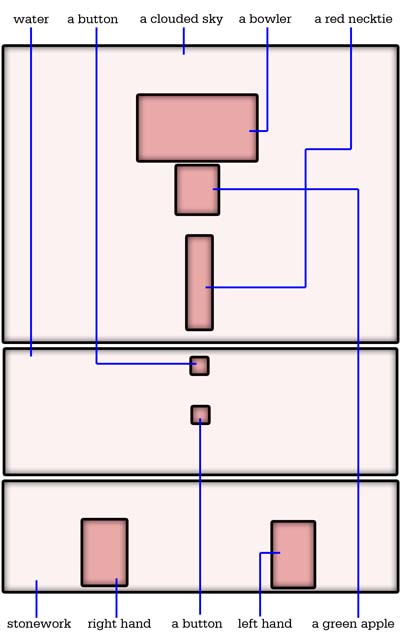
Highlight what hints you need below:
| Hint 1 | The foreground objects are more important than background. |
| Hint 2 | Sketch a figure that joins the foreground objects. Some elements of the figure must be implied. |
| Hint 3 | One of the objects is strangely suspended. |
| Hint 4 | It is the apple. How could the apple be in it's current position? |
| Hint 5 | Perhaps there is not a rational explanation. Not all paintings show things which could exist. |
| Hint 6 | Just concentrate on that apple. It is inexplicably floating in front of somebody's face. |
| Hint 7 | There is a famous painting of a man in a suit with an apple covering his face. That painting is... |
| Solution | The Son of Man by Rene Magritte |
Puzzle 2
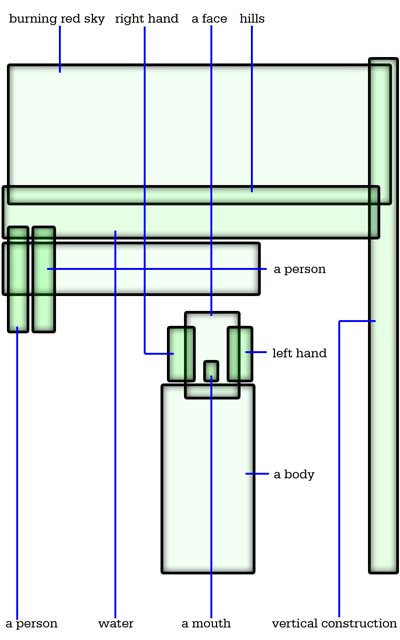
Highlight what hints you need below:
| Hint 1 | There are three people shown. How is it that two of them cover a much smaller area of the painting? |
| Hint 2 | Perspective, of course. |
| Hint 3 | The focal point of the painting is the nearest person. |
| Hint 4 | The near person's stance is unusual. Sketch a realistic figure which satisfies the locations of labelled elements. |
| Hint 5 | Particularly the hands give this painting away. |
| Hint 6 | The hands are covering the ears. Think of different circumstances when a person would cover their ears. |
| Hint 7 | The painting is titled after an act performed by the near person. |
| Solution | The Scream by Edvard Munch |
Puzzle 3
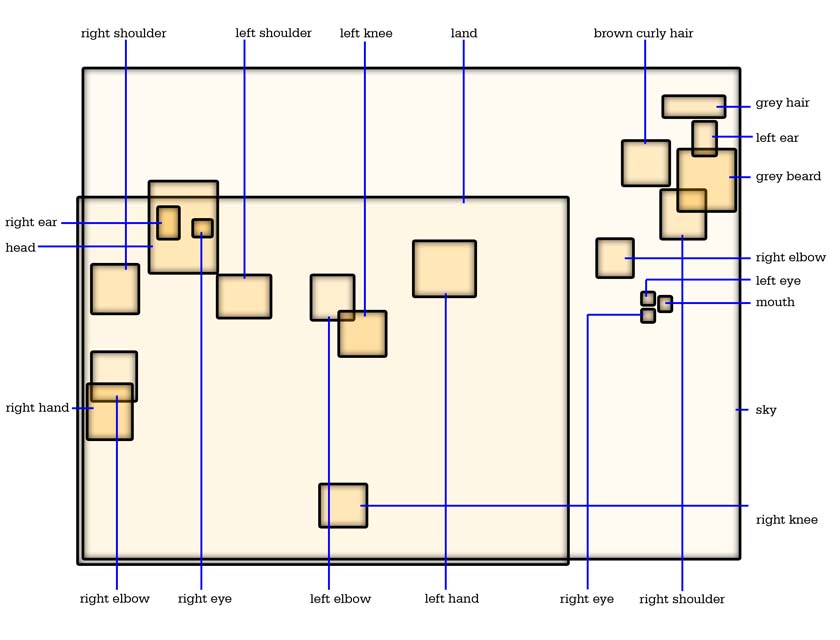
Highlight what hints you need below:
| Hint 1 | Sketching helps. |
| Hint 2 | Important elements that might quickly identify the work are left out. |
| Hint 3 | These same elements can be implied, however. |
| Hint 4 | There are four people shown in this painting. |
| Hint 5 | Three are on the right. You might try untangling them. |
| Hint 6 | The posture of the left person is telling. |
| Hint 7 | The left figure is on land. The right figures are in the sky. |
| Solution | The Creation of Adam by Michelangelo |
Puzzle 4
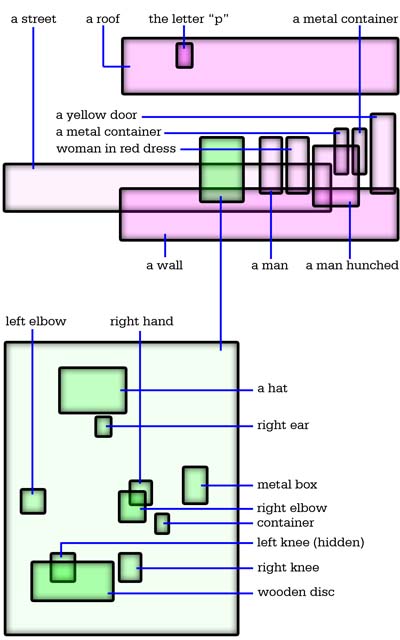
Highlight what hints you need below:
| Hint 1 | The green area is a magnified section of the overall painting shown in purple. |
| Hint 2 | Determining the type of place depicted is key. |
| Hint 3 | Some items shown will give a rough idea of the time period. |
| Hint 4 | The posture of the magnified person is a clue of the type of location. |
| Hint 5 | The letter on the roof suggests a sign. This is some kind of shop. |
| Hint 6 | Perhaps the most notable feature of the original painting is the large empty space between roof and lower wall. |
| Hint 7 | It is a bar on a corner with very large windows. |
| Solution | Nighthawks by Edward Hopper |
Puzzle 5
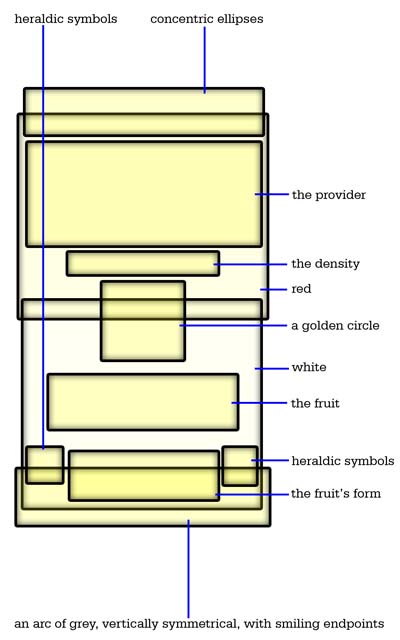
Highlight what hints you need below:
| Hint 1 | The colors themselves may give it away. |
| Hint 2 | The heraldic symbols have appeared in many places before. |
| Hint 3 | The provider is named but not shown. |
| Hint 4 | Likewise for the density, the fruit, and the fruit's form. |
| Hint 5 | The subject of the painting is a single physical object. |
| Hint 6 | You could hold it in your hand. |
| Hint 7 | You could buy it at a supermarket. |
| Solution | Tomato: Campbell Soup by Andy Warhol |
I hope you've enjoyed these. There are some more abstracted art puzzles and discussion here.
-Erik Hermansen
erikh@caravelgames.com
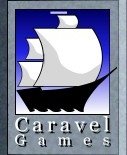
![[ Downloads ]](../ScreenPartImages/downloads_out.png)
![[ Play Online ]](../ScreenPartImages/playnow_side.jpg)
![[ Forum ]](../ScreenPartImages/forum.jpg)
![[ News ]](../ScreenPartImages/news.jpg)
![[ Fan Site ]](../ScreenPartImages/fansite_out.png)
![[ About Us ]](../ScreenPartImages/aboutus.jpg)
![[ Contact ]](../ScreenPartImages/contact.jpg)